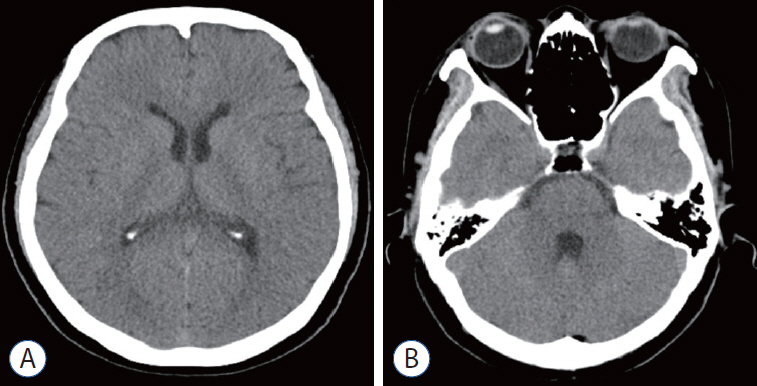J Korean Neurosurg Soc.
2022 Mar;65(2):325-330. 10.3340/jkns.2021.0122.
Direct Removal of Fourth Ventricle Hematoma in Massive Intraventricular Hemorrhage
- Affiliations
-
- 1Department of Neurosurgery, Chonnam National University Hospital, Chonnam National University Medical School, Gwangju, Korea
- KMID: 2527189
- DOI: http://doi.org/10.3340/jkns.2021.0122
Abstract
- Various grading systems and surgical techniques have been developed for the treatment of intraventricular hemorrhage (IVH); however, little attention has been paid to the fourth ventricle hematoma. Nonetheless, hemorrhagic dilation of the fourth ventricle may lead to catastrophic consequences for patients with massive IVH. We present two cases of massive IVH accompanied by massive fourth ventricle hematoma which was successfully removed with combination of suboccipital craniotomy for fourth ventricle hematoma and intraventricular fibrinolysis for supratentorial hematoma.
Figure
Reference
-
References
1. Di Rienzo A, Colasanti R, Esposito D, Della Costanza M, Carrassi E, Capece M, et al. Endoscope-assisted microsurgical evacuation versus external ventricular drainage for the treatment of cast intraventricular hemorrhage: results of a comparative series. Neurosurg Rev. 43:695–708. 2020.
Article2. Donauer E, Loew F, Faubert C, Alesch F, Schaan M. Prognostic factors in the treatment of cerebellar haemorrhage. Acta Neurochir (Wien). 131:59–66. 1994.
Article3. Feletti A, Basaldella L, Fiorindi A. How I do it: flexible endoscopic aspiration of intraventricular hemorrhage. Acta Neurochir (Wien). 162:3141–3146. 2020.
Article4. Findlay JM, Grace MG, Weir BK. Treatment of intraventricular hemorrhage with tissue plasminogen activator. Neurosurgery. 32:941–947. discussion 947. 1993.
Article5. Gaberel T, Magheru C, Emery E. Management of non-traumatic intraventricular hemorrhage. Neurosurg Rev. 35:485–494. discussion 494-495. 2012.
Article6. Graeb DA, Robertson WD, Lapointe JS, Nugent RA, Harrison PB. Computed tomographic diagnosis of intraventricular hemorrhage. Etiology and prognosis. Radiology. 143:91–96. 1982.
Article7. Hamada H, Hayashi N, Kurimoto M, Umemura K, Nagai S, Kurosaki K, et al. Neuroendoscopic removal of intraventricular hemorrhage combined with hydrocephalus. Minim Invasive Neurosurg. 51:345–349. 2008.
Article8. LeRoux PD, Haglund MM, Newell DW, Grady MS, Winn HR. Intraventricular hemorrhage in blunt head trauma: an analysis of 43 cases. Neurosurgery. 31:678–684. discussion 684-685. 1992.9. Li Y, Zhang H, Wang X, She L, Yan Z, Zhang N, et al. Neuroendoscopic surgery versus external ventricular drainage alone or with intraventricular fibrinolysis for intraventricular hemorrhage secondary to spontaneous supratentorial hemorrhage: a systematic review and meta-analysis. PLoS One. 8:e80599. 2013.
Article10. Martí-Fàbregas J, Piles S, Guardia E, Martí-Vilalta JL. Spontaneous primary intraventricular hemorrhage: clinical data, etiology and outcome. J Neurol. 246:287–291. 1999.
Article11. Mei L, Fengqun M, Qian H, Dongpo S, Zhenzhong G, Tong C. Exploration of efficacy and safety of interventions for intraventricular hemorrhage: a network meta-analysis. World Neurosurg. 136:382–389.e6. 2020.12. Morgan TC, Dawson J, Spengler D, Lees KR, Aldrich C, Mishra NK, et al. The modified Graeb score: an enhanced tool for intraventricular hemorrhage measurement and prediction of functional outcome. Stroke. 44:635–641. 2013.13. Shapiro SA, Campbell RL, Scully T. Hemorrhagic dilation of the fourth ventricle: an ominous predictor. J Neurosurg. 80:805–809. 1994.
Article14. Song P, Duan FL, Cai Q, Wu JL, Chen XB, Wang Y, et al. Endoscopic surgery versus external ventricular drainage surgery for severe intraventricular hemorrhage. Curr Med Sci. 38:880–887. 2018.
Article15. Tuhrim S, Horowitz DR, Sacher M, Godbold JH. Volume of ventricular blood is an important determinant of outcome in supratentorial intracerebral hemorrhage. Crit Care Med. 27:617–621. 1999.
Article16. Weisberg LA. Acute cerebellar hemorrhage and CT evidence of tight posterior fossa. Neurology. 36:858–860. 1986.
Article17. Yilmazlar S, Abas F, Korfali E. Comparison of ventricular drainage in poor grade patients after intracranial hemorrhage. Neurol Res. 27:653–656. 2005.
Article
- Full Text Links
- Actions
-
Cited
- CITED
-
- Close
- Share
- Similar articles
-
- Spontaneous Cerebellar Hemorrhage with the Fourth Ventricular Hemorrhage : Risk Factors Associated with Ventriculoperitoneal Shunt
- A Case of Intraventricular Meningioma Acompanied by Intraventricular Hematoma and Subarachnoid Hemorrhage: Case Report
- Clinical-Computed Tomographic Correlation of Spontaneous Intraventricular Hemorrhage Patients
- Prognostic Factors in Spontaneous Thalamic Hemorrhage
- An Experimental Study about the Effect of Urokinase Injected into the Ventricle on Intraventricular Hemorrhage







